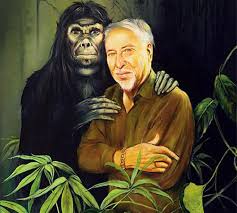
Bernard Heuvelmans was born on October 10, 1916, in Le Havre, France, and raised in Belgium. He earned a doctorate in zoology from the Free University of Brussels (now split into the Université Libre de Bruxelles and the Vrije Universiteit Brussel). His doctoral dissertation investigated the teeth of the aardvark, which had previously defied classification. Though earlier interested in zoological oddities (since reading Conan Doyle’s 1912 novel The Lost World), Heuvelmans always credited the January 3, 1948 Saturday Evening Post article, “There Could be Dinosaurs,” by Ivan T. Sanderson with inspiring his passionate interest in unknown animals (cryptids). Sanderson discussed the possibility of dinosaurs surviving (cryptozoologically) in remote corners of the world.
Heuvelmans and Sanderson are seen as the “Godfathers of Cryptozoology.”
In the course of letter-writing, Heuvelmans, unaware that Sanderson had independently coined the term, invented the word “cryptozoology” (it does not appear in his book On the Track of Unknown Animals). That word saw print in French for the first time in 1959 when French wildlife official Lucien Blancou dedicated a book to the “Master of Cryptozoology.”

The word saw print in English, for the first time, in Ivan T. Sanderson’s Abominable Snowmen: Legend Come to Life, in 1961.
Sanderson passed away on February 19, 1973, and so by the end of Heuvelmans’ life at Le Vesinet, France, at 84, on August 22, 2001, the French-Belgian cryptozoologist was clearly seen as the elder statesman of the field.

Heuvelmans corresponded with many cryptozoologists worldwide, as he did with me, over the decades. I was able to meet him once, at the International Society of Cryptozoology meeting in New York City. By the 1960s, most in the field had elevated Blancou’s phrase in honor of Heuvelmans, and Heuvelmans was being called the “Father of Cryptozoology.”

A close friend and disciple of cryptozoologist Bernard Heuvelmans, Jean-Jacques Barloy (d. January 26, 2013) wrote the well-respected biography on Heuvelmans’ life entitled, Bernard Heuvelmans: Un Rebelle de la Science (Bernard Heuvelmans: A Science Rebel), published in February 2007.
While the Heuvelmans’ biography is in French, it is a little known fact that Barloy did a first round of translating the captions, and then asked me to assist him with correcting their English and adding details to each about the individuals pictured. His book was published with those Loren Coleman captions. Considering that I do not know French, I was honored to be trusted with the captions in English. Unfortunately, other than the captions, this biography awaits translation from French to English.





Heuvelmans’ foundation book in cryptozoology, On the Track of Unknown Animals, first appeared in French in 1955, and then in English in 1958. Various editions have appeared, and it has been widely disseminated in English. Heuvelmans’ important book, In the Wake of the Sea-Serpents, previously published as two books in French, appeared in English, in 1965.

During 2016, thanks to a translation by Paul LeBlond, Bernard Heuvelmans’ portion of 1974′s L’Homme de Néanderthal est toujours vivant will appear in English, as Neanderthal: The Strange Saga of the Minnesota Iceman (from Anomalist Books). It will contain a special Heuvelman’s introduction, LeBlond’s notes, and a detailed “Afterword” by yours truly, Loren Coleman, with references.

It is hoped that Heuvelmans’ other books, now only available in French, will be translated in the future. Perhaps someone will see Heuvelmans’ 100th year as the appropriate one to get these French texts translated into English!

Art by Bernard Heuvelmans’ ex-wife and lifelong friend, Alika Lindbergh.
<><><><><><><><><><><><><><><><><><><><><><><><><><><><><><><><><><><>
Support the future of Cryptozoology. Become a member of the International Cryptozoology Society today!!

Follow CryptoZooNews
Not Found
The resource could not be found.